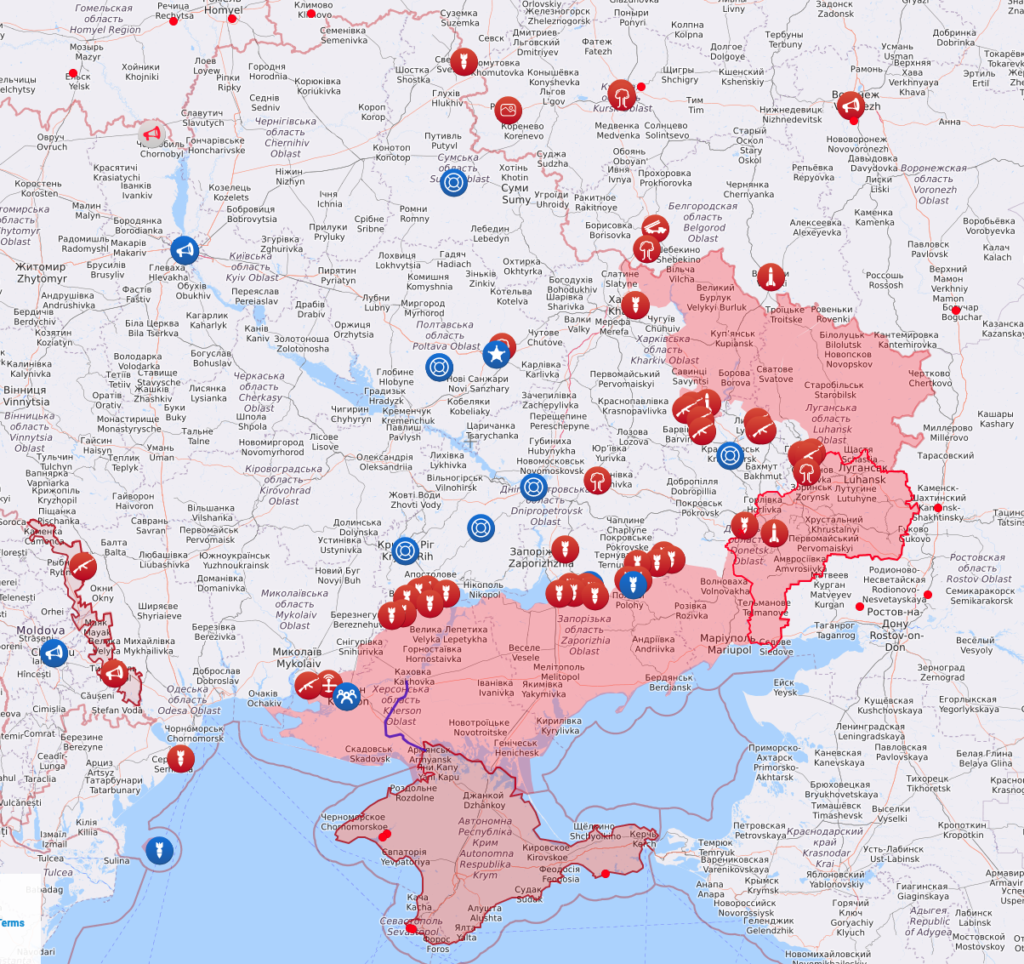Something interesting is unfolding in the skies over Ukraine’s south-central front. Over the last ten days, Ukraine has managed to shoot down no less than 12 Russian military aircraft:
First the shootdown list:
For what it’s worth, Livemap says that Ukraine shot down two Su-34s today.
David Axe at Forbes suggests that Russia’s air arm is dangerously close to collapse.
The Russian air force lost another Sukhoi Su-34 fighter-bomber on Thursday, the Ukrainian air force claimed. If confirmed, the Thursday shoot-down would extend an unprecedented hot streak for Ukrainian air-defenses.
The Ukrainian claim they’ve shot down 11 Russian planes in 11 days: eight Su-34s, two Sukhoi Su-35 fighters and a rare Beriev A-50 radar plane.
But those 11 claimed losses are worse than they might seem for the increasingly stressed Russian air force. In theory, the air arm has plenty more planes. In practice, the service is dangerously close to collapse.
Exactly how the Ukrainians are shooting down so many jets is unclear. It’s possible the Ukrainian air force has assigned some of its American-made Patriot missile launchers to mobile air-defense groups that move quickly in close proximity to the 600-mile front line of Russia’s two-year wider war on Ukraine, ambushing Russian jets with 90-mile-range PAC-2 missiles then swiftly relocating to avoid counterattack.
But the distance at which the Ukrainians shot down that A-50 on Friday—120 miles or so—hints that a longer-range missile system was involved. Perhaps a Cold War-vintage S-200 that the Ukrainian air force pulled out of long-term storage.
It also is apparent the Ukrainians have moved some of their two-dozen or so 25-mile-range NASAMS surface-to-air missile batteries closer to the front line. After all, the Russians found—and destroyed with a missile—their first NASAMS launcher near the southern city of Zaporizhzhia on or before Monday.
He also suggests Russia may be flying more sorties close to the lines to follow-up on its costly victory in Avdiivka.
This surge in Russian sorties presents Ukrainian air-defenders with more targets. So of course they’re shooting down more Russian planes.
It helps the Ukrainian effort that Russian pilots increasingly are blind to Ukrainian missile-launches. The Russian air force once counted on its nine or so active A-50 radar planes—organized into three, three-plane “orbits” in the south, east and north—to extend sensor coverage across Ukraine.
In damaging one A-50 in a drone strike last year and shooting down two more A-50s this year, the Ukrainians have eliminated a third of this sensor coverage, and created blind spots where Russian pilots might struggle to spot approaching missiles.
In any event, the consequences of the Ukrainians’ recent kills, for the Russians, are dire. The Russian air force is losing warplanes far, far faster than it can afford to lose them. Russia’s sanctions-throttled aerospace industry is struggling to build more than a couple of dozen new planes a year.
Escalating losses, exacerbated by anemic plane-production, almost certainly are increasing the stress on the surviving planes and crews. The Russian air arm isn’t yet in an organizational death spiral. But it’s getting closer.
The numbers tell the story. On paper, the Russian air force has acquired 140 of the twin-engine, two-seat, supersonic Su-34s. Counting this year’s unconfirmed losses, the air force has lost 31 of the Su-34s.
But 109 Su-34s still is a lot of Su-34s, right?
Wrong, according to Michael Bohnert, an engineer with the RAND Corporation in California. Shoot-downs represent “only a portion of total losses” of Russian fighters, Bohnert wrote back in August. “Overuse of these aircraft is also costing Russia as the war drags on.”
“In a protracted war, where one force tries to exhaust the other, it’s the total longevity of the military force that matters,” Bohnert added. “And that’s where the VKS”—the Russian air force—“finds itself now.”
Bohnert assumed the air force went to war two years ago with around 900 fighters and attack planes and, in the first 18 months of fighting, lost around 100 of them to Ukrainian action. The problem for the Russians—besides the losses—is that the requirement for fighter and attack sorties hasn’t decreased even as the fighter and attack inventory has decreased.
So those 800 remaining planes are flying more frequently in order to handle taskings the Kremlin once assigned to 900 planes. And that means more wear and tear, deepening maintenance needs and a growing hunger for increasingly hard-to-find spare parts—imperatives that effectively remove airframes from the front-line force.
Given what we know of lax Russian maintenance practices, it’s probably safe to assume that considerably less of those 100 Su-34s are mission capable than would be the case in, say, the U.S. Air Force, which have mission-ready goals of 75-80%, but frequently falls short.
A few more weeks of disasterous losses like this and Russia will be at dire risk of having what remains of it’s air campaign collapse.
And Ukraine still has F-16s due to enter service this year.

 (@NoYardstick)
(@NoYardstick)